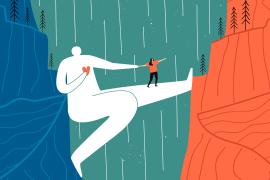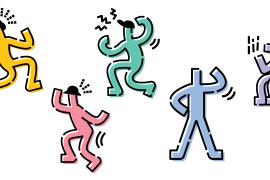July 2015. Camp was in full swing with little time to devote to the Internet, but the news feed picked up an item that caught my attention.
It was an article published by the national news outlet of the Aboriginal Peoples Television Network (APTN). It was a provocative item about the mimicry of indigenous practices and ceremonies at a couple of summer camps in Ontario, Canada (APTN, 2015). The “Indian” styled pageants and activities reported on — hallmark traditions of the featured camps — were cited by a First Nations Chief as being offensive and contributing to the reinforcement and proliferation of racial stereotypes among impressionable young white people. Within the context of this discourse, it is important that I identify myself as a white, Jewish, Canadian male, of Eastern European grandparentage, living and operating a camp on lands that were at one time inhabited by the Huron-Wendat peoples.
Although I live in Canada, this issue is not limited to camps on my side of our mutual border. “Indian” event days, quasi-ceremonial council rings, and Indian games, crafts, and icons have been present at summer camps throughout North America since the early 20th century. One has only to note the many camps across the continent that have taken their names from the languages of Native American tribes.
The History
This history is actually the legacy of Ernest Thompson Seton and his Woodcraft Indians movement (1917), which is foundational to many summer camps as we know them. Seton’s “Indian teachings” were based on a homogeneous concept of indigenous peoples whereby the tenets and teachings of many North American tribal nations were woven together into a universal moral and spiritual code. By 1910, the League of Woodcraft Indians was the largest youth organization in North America (Francis, 1992). Many camps in the US and Canada have long traditions of programs which, although inspired by North American indigenous cultures, are actually rooted in Seton’s Woodcraft model and his associated curricula.
Seton’s model, while instructive, was not authentic to any particular first nation. It did, however, try to honor the indigenous peoples of North America and was intended to teach young people, albeit parochially, to be like Native Americans before contact with the white man, “an Indian with all that is bad and cruel left out — proud, honorable, a child of the wilderness, master of woodcraft skills” (Francis, 1992).
It should be noted that some camps have already established strong bonds of friendship and cooperation with local Native American leaders. To do so is the ideal way to incorporate honest, meaningful, and joyful Native American teachings and practices into a camp setting.
We have not had an “Indian Day” at our camp for a number of years now. Although I remember playing at being Indians as a special event from my own childhood experiences at camp, attempts at our camp to honor a culture we really didn’t know anything about fell flat. A member of the Métis, officially recognized indigenous people of mixed race, admonished us. When asked if he would assist and participate in our event day he categorically refused, citing racial stereotyping. He said what we had planned falsely portrayed his culture and was an affront to his people. He would have nothing to do with it.
Despite our attempt to bring in a representative of the native community it was still our agenda based on Seton’s fanciful curriculum. We honored none of the indigenous nations, learned nothing of their heritage, and failed to recognize their individual histories and present-day struggles. This was not something we wished to impart to our campers or staff, so we decided to retire the program.
A Way Forward
The fact that we ended our indigenous peoples-inspired programs didn’t have much impact because we had not been delivering these programs long enough for them to have taken root with our alumni. However, this is not the case for many camps. One possible way forward is for camp educators to shift the focus away from the problematic tradition itself and focus rather on the sociocultural context that allows it to proliferate (Shore, 2015). Camps cannot and should not eliminate what has become an important part of camp history. They cannot be expected to change section groupings, team names, competitions, and related programs that were originally made up to pay homage to indigenous cultures; but they can rethink their particular circumstances with the purpose of putting an end to misinformation and by coming up with more respectful and educative activities. The process as to how this informed change takes place will then become a cogent extension of the camp’s history and tradition.
Jim Adams, also known as Bear Who Walks from the South, is a member of the Matawa Tribal Council and an indigenous storyteller (The Royal Conservancy, 2016). He has consulted with and facilitated at Camp Ahmek in Ontario’s Algonquin Park. Camp Ahmek holds the distinction of being the camp where Charles Hendry and Hedley S. Dimock (ACA, 2016) undertook research in the early 20th century for their seminal text on organized camping, Camping and Character (1931). Adams commented at the Ontario Camps Association Annual Conference that his intentions were not to tear down any of the camp’s traditions but rather filter out aspects of the programming that were disrespectful to indigenous peoples (2016). The importance was to dialogue and work together with the camp so that the campers would begin to understand the ancient stories of the First Nations and learn more about the true foundations of their camp’s heritage. Sensory experiences of sights, sounds, tastes, and smells are important components to Bear’s storytelling
A Time-Honored Practice
I’m emphasizing a couple of things here. First, that there is a time-honored practice of cooperation between US and Canadian camps and camp professionals. This cooperative attitude will be officially expanded in 2017 through a collaborative agreement that has been ratified between the ACA and the Canadian Camping Association. We will soon have a common conduit for the sharing of research, resources, and ideas between our associations.
Second, the lineage of indigenous peoples along the US-Canada border share the same kinship both north and south. The ancestral lands of the indigenous peoples of North America transcend the political boundaries originally imposed by European powers. Four distinct indigenous languages — Algic, Iroquoian, Siouan, and Salishan — span the continent from east to west. North and south, the Algic language was once spoken from Alabama north to Hudson’s Bay and from the Maritimes to the Dakotas. Since 1794, the American government through the Jay Treaty (Pine Tree Legal Assistance, 2016) has guaranteed the right of Native Americans to trade and travel freely between the United States and Canada (which was then a territory of Great Britain). Although some native reserves span the border, such as the Iroquois of the Six Nations in New York State and Ontario, a different set of international boundary policies are in effect for First Nation peoples living on the Canadian side of the border (Mohawk Council of Akwesasne, 1999).
Opportunities
The KAIROS Blanket Exercise
One way to impart both the historic and modern-day contexts of indigenous peoples to a broad audience is through the KAIROS Blanket Exercise, which you can learn more about at kairosblanketexercise.org (KAIROS, 2013). This is a dynamic, interactive, group activity that takes place between an indigenous leader participant(s) and non-native participants. The blanket exercise is a perfect fit for camps that have a traditional program based on indigenous customs and practices. It is one way to maintain the continuity of the camp’s Native American component while providing an experiential learning event that honors and respects indigenous peoples without falling into traps of cultural approbation or stereotyping.
The Blanket Exercise tells the story of North American indigenous peoples presented through a scripted time line. Blankets representing the traditional land areas of the indigenous nations are spread on the ground. Participants then speak the words, which include voices of Native elders and leaders, explorers, solders, settlers, and political figures. The participants walk across the blankets and history, altering the blankets’ coverage and arrangement as the time line advances. It relates to a world history profoundly affected in the 15th century by the European Doctrine of Discovery (Newcomb, 1992). It identifies aboriginal lands, how these were subsumed by colonizers, and how tribal communities became broken and scattered. This history also has parallels to the histories of many indigenous peoples globally who have been similarly affected. The stories of the indigenous peoples of North America need to be known by the broad diversity of peoples from around the globe who now call the US or Canada their home.
Moving forward to a better understanding of Native American/First Nations culture in the 21st century begins with a better understanding of their history. The Blanket Exercise is a popular education exercise that will continue to evolve, change, and include others. This experiential encounter concretizes the historical events of the indigenous peoples and has the potential to shape the future for all inhabitants of our planet. The American Blanket Exercise script that KAIROS is currently developing with their partners in the US is a work-in-progress that has been facilitated a number of times to very positive reviews.
Native American Storytelling
As Bear Who Walks from the South emphasized, sensory-based storytelling is an effective way to incorporate indigenous knowledge and make a lasting impression on the young people in your camp community. Given the varying locations of camps across the nation, it is not always possible to gain access to a Native American storyteller, but ACA’s professional development resources offer Sky Tellers, an audio selection of ten Native American storytellers that allows campers the freedom to use their imaginations under the night sky to explore the mysteries of the universe (2016). Themes including day and night, seasons, moon phases, the sun, and others are presented. The Native American stories are based on ancient myths and legends of the Native American peoples, but the theories of modern science are included for each as well. The storytellers are descended from different tribes and their stories have been handed down for generations. The science stories are told by Chickasaw/Okie storyteller Lynn Moroney, as well as Captain John Herrington, the first Native American astronaut in space. The beauty of the program is that it can be presented to and enjoyed by indigenous and non-indigenous campers alike; and encourages both acknowledgment and questioning through imagination, creativity, and wonder.
The Wampum Belt as Shared Artifact
Looking for ways to present Native American-based programming without becoming ensnared in allegations of cultural appropriation can be a challenge. Camp directors have to either engage the presence of a Native American facilitator or seek knowledge of artifacts and practices that were common to both indigenous peoples and settlers. Tad McIlwraith, professor of anthropology at the University of Guelph, points to the fact that Native American elders acknowledge the wampum belt as a shared cultural artifact that is as much a settler object as it is a Native American object (2016). As such, the making of these objects for arts and crafts or to commemorate camp events or milestones can be a way to honor Native American culture and also be representative of a camp’s individual traditions or heritage unencumbered.
Within this context it is important for campers to understand historically what the wampum belt signified and the relationship it confirmed between two peoples. The wampum belt conveys an understanding that treaties between Native Americans and settlers, although forged in the past, still have relevance today as covenants that symbolize a continuation of this relationship.
Camp Traditions
Today’s camp directors are well aware of changing social norms, emerging social justice issues, and an increasingly regulated environment. As a result, summer camps find themselves consistently challenged to engage in a process of self-reflectivity which often calls for the re-evaluation of both the content and delivery of programs that may be steeped in long-standing camp tradition. In the instance of an “Indian” event day or associated indigenous-inspired curricula, repetitive programming based solely on maintaining a camp tradition and devoid of any process toward reflective practice can turn a well-intentioned camp activity into fertile ground for naive acts of cultural appropriation and the reinforcement of stereotypes (Shore, 2015).
Current evidence-based research recognizes the powerful capacity of camp experience for contextual learning, enduring recollection, and learning transfer (Fine, 2005). We do not want to be seen as naively sending out a wrong message. Both the American Camp Association and the Canadian Camping Association, through their research endeavors and staff training, strive to achieve a culture for continuous self-improvement and study toward all aspects of camping with the intent to interpret and disseminate a growing body of knowledge.
|
KAIROS |
| Sky Tellers Sky Tellers is a collaborative project between the Lunar and Planetary Institute and Chickasaw/Okie storyteller Lynn Moroney, and was funded by the National Science Foundation. To access the Sky Teller audio program, visit ACAcamps.org/resource-library/professional-development/native-american-night-sky-storytelling. |
| More on Wampum Belts Information on wampum belt history and usage can be found at the Friends of Ganondagan website, ganondagan.org/Learning/Wampum, hosted by the Seneca Peoples of the Six Nations Iroquois, New York State. A wampum belt craft project that is suitable for camps can be found on the Home School Life Journal website at http://homeschooljournal-bergblog.blogspot.ca/ 2011/06/making-wampum-and-wampum-belt.html. |
Stephen Fine, PhD, is a camp director in Ontario, Canada, Research Chair for the Canadian Camping Association, and ex officio member of ACA’s Committee for the Advancement of Research and Evaluation.
Photo courtesy of KAIROS: Canadian Ecumenical Justice Initiatives, Toronto, Canada
References
- Aboriginal Peoples Television Network. (2015, July). Chief insulted by mock indigenous ceremonies at two Ontario summer camps. Retrieved from http://aptn.ca/news/2015/07/15/two-ontario-summer-camps-need-stop-indig…
- American Camp Association. (2016). Biography of Hedley S. Dimock. Retrieved from ACAcamps.org/sites/default/files/page_documents/about/Dimock-Biography.pdf
- American Camp Association. (2016). Native American night sky storytelling. Retrieved from ACAcamps.org/resource-library/professional-development/native-american-night-sky-storytelling
- Dimock, H.S., & Hendry, C.E. (1931). Camping and character: A camp experiment in character education. New York, NY: Association Press.
- Fine, S.M. (2005). Contextual learning within the residential outdoor experience: A case study of a summer camp community in Ontario. Retrieved from http://ccamping.org/wp-content/uploads/2012/11/Fine_Stephen_2005_Contex…
- Francis, D. (1992). The imaginary Indian. Vancouver, BC: Arsenal Pulp Press.
- KAIROS. (2013). The Kairos blanket exercise, third edition. Retrieved from http://spiritoftheland.ca/wp-content/uploads/2014/04/Blanket-Exercise.p…
- McIlwraith, T. (2016). Biography of Thomas “Tad” McIlwraith. Retrieved from tadmcilwraith.com
- Mohawk Council of Akwesasne. (1999). Aboriginal border crossing rights and the Jay Treaty of 1794. Retrieved from akwesasne.ca/node/119
- Newcomb, S. (1992). Five hundred years of injustice: The legacy of fifteenth century religious prejudice. Retrieved from http://ili.nativeweb.org/sdrm_art.html
- Ontario Camps Association Annual Conference. (2016). Indigenous cultures and camps: A panel discussion. Personal observation. Markham, ON.
- Pine Tree Legal Assistance. (2016). Border crossing rights under the Jay Treaty. Retrieved from http://ptla.org/border-crossing-rights-jay-treaty
- The Royal Conservancy. (2016). Learning through the arts artist bio: Jim Adams. Retrieved from https://learning.rcmusic.ca/learning-through-arts/artist-educator-biogr…
- Seton, E.T. (1917). The woodcraft manual for boys: The fifteenth birch bark roll. Garden City, NY: Doubleday. Retrieved from http://etsetoninstitute.org/wp-content/uploads/2012/09/The_woodcraft_ma…
- Shore, A. (2015). Notes on camp: A decolonizing strategy. Halifax, NS: NSCAD University. Retrieved from ccamping.org/wp-content/uploads/2015/05/A.Shore-Notes-On-Camp.pdf



